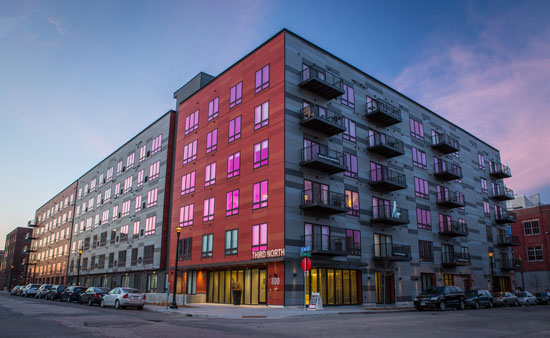Design Innovations Using Fiber Cement in Commercial Construction
AAMA 501.1 Standard Test Method for Water Penetration of Windows, Curtain Walls and Doors Using Dynamic Pressure
Similar to the ASTM test above, this standard test developed by The American Architectural Manufacturers Association (AAMA) establishes the equipment, procedures and requirements for optional laboratory testing of exterior windows, curtain wall and door systems for water penetration. However this test is based on using dynamic pressure instead of static pressure to see the range of performance. As such, this is not a “pass/fail” type of test as many are, rather it is intended to show performance at different pressures. It is also intended to simulate real world conditions of wind driven rain against a building.
AAMA 509-9 Voluntary Test and Classification Method of Drained and Back Ventilated Rain Screen Wall Cladding Systems
As we have seen, most of tests discussed so far were designed for some other purposes such as water and air penetration through the supporting back up wall or through fenestration systems. In response, AAMA recognized the need to develop testing that was specific to rainscreen wall cladding systems, such as fiber cement wall panels. Hence, AAMA 509-9 was developed for the primary purpose of quantifying the volume of rain water contacting an imperfect Air and Water Barrier (AWB) and the system's ability to allow for ventilation/drying as measured by air flow through the system. It is understood that water will reach the AWB which is both acceptable and anticipated. The question is how much water and whether the system is capable of allowing for subsequent drainage and drying. Under this test, there are four (4) essential design requirements that must be demonstrated:
▶ Water entry must be prevented from penetrating into or through the entire wall system (i.e. penetrating the AWB)
▶ The AWB shall be designed to provide the primary weather protection
▶ The wall system shall be designed to manage and drain any water entering the cavity behind the cladding. It shall also be sufficiently vented to allow the cavity to dry
▶ In the event that water vapor diffuses through the wall and AWB from the building interior and ultimately into the wall panel cavity, that water vapor shall be permitted to be vented and/or drained out to the exterior.
NFPA 285 Standard Fire Test Method for Evaluation of Fire Propagation Characteristics of Exterior Non-Load-Bearing Wall Assemblies Containing Combustible Components
This standard provides a standardized fire test procedure for evaluating the suitability of exterior, non-load bearing wall assemblies and panels used as components of curtain wall assemblies that are constructed using combustible materials or that incorporate combustible components for installation on buildings where the exterior walls are required to be non-combustible. Generally speaking most fiber cement products are not rated as combustible, however portions of the rest of the wall assembly might be, such as foam insulation products. The importance of this fire safety standard is that it does not test individual materials, rather it tests full assemblies. Further, it is referenced in the International Building Code as the standard to show code compliance for non-combustible exterior walls. Therefore, while the fiber cement wall panels can contribute to better compliance, the specific wall assembly as designed will need to show that it has been tested and passed this standard fire test method.
Specifying Fiber Cement Architectural Wall Panels Guidelines
In light of all of the above, there are a number of things to be cognizant of when specifying fiber cement architectural wall panels for commercial buildings. First, it is always recommended that manufacturers are contacted during the design process to determine specific capabilities, options, and system coordination items while they can be readily addressed. This is particularly important for taller buildings subject to greater weathering stresses and specific installation requirements. Once a specific type or types of fiber cement panels are decided upon, it will be appropriate to request manufacturer samples and submittals including product lead times to be sure that construction schedules are being met. It is then important to identify the appropriate testing requirements that should be asked for such as AAMA 509-9. Other testing requirements should be specific to the type of rainscreen or other wall system envisioned.

Photo courtesy of Nichiha USA, Inc.
Custom or standard colors can be specified for fiber cement architectural wall panels to suit a particular building design.
In terms of the particular products, all of the options and details will need to be listed. This will include the details of the panels such as size, color, and texture, but also the details and requirements for the installation system. If an open joint system is called for, then the channel system will need to be called out in detail and indicated on the drawings. If a closed joint system is preferred, then the clip installation system can be specified as part of the manufacturer's standard installation system. Other third party components or wall system requirements such as sealants, flashings, trims, and fasteners should all be called out as well and will need to be verified as compatible with the selected fiber cement panel products.










